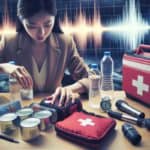Comprehensive Guide to Distress Signal Methods for Emergency Situations
What Are Distress Signals and Their Importance?

Distress Signal Methods: Distress signals serve as vital communication tools that convey emergencies and summon assistance across diverse scenarios. They function as a beacon of hope for those in danger, effectively connecting individuals in distress with potential rescuers. These signals manifest in various forms, each specifically designed to enhance visibility or audibility based on the situation at hand. Recognising the significance of distress signals is paramount for anyone navigating remote or perilous environments, whether on land, at sea, or in the air. Typical distress signals encompass:
- Flare guns
- Whistles
- Signal mirrors
- Smoke signals
- Personal locator beacons (PLBs)
- Air horns
- Emergency beacons
- Satellite phones
In critical situations, the swift identification and response to distress signals can prove to be the defining factor between survival and tragedy. Effectively utilising these signals empowers individuals to request help promptly, ensuring that those who come to their aid can locate and assist them with utmost efficiency.
Exploring the Different Types of Distress Signals
Distress signals are categorised into two primary types: visual signals and auditory signals, each presenting distinct benefits and limitations. Visual signals rely on sight, encompassing methods such as flares, signal mirrors, and smoke signals. These tools are especially advantageous in open areas, where they can be spotted from significant distances. Conversely, auditory signals rely on sound, exemplified by whistles and air horns, making them particularly effective in conditions where visibility is impaired.
Understanding the unique applications and ideal circumstances for each type of distress signal is essential. For instance, flare guns are highly effective during nighttime or in low-light conditions, while signal mirrors leverage sunlight during the day for maximum visibility. Understanding these differences is crucial for selecting the most suitable distress signal in a specific environment, given the available resources.
Why Distress Signals Are Essential for Survival
The significance of distress signals cannot be overstated; they serve as critical lifelines in times of emergency. Proficient use of distress signals significantly enhances survival probabilities, enabling individuals to inform rescuers of their precise location and circumstances quickly. When someone becomes lost or injured, the ability to communicate distress immediately can lead to significantly faster rescue operations.
Moreover, understanding how to use distress signals instills a sense of safety and reassurance among individuals exploring unfamiliar landscapes. The knowledge that help can be summoned at any moment empowers people to traverse remote regions, knowing they possess the means to call for assistance during a crisis. The psychological benefits of being able to signal for help are profound; they offer not just hope but also a measure of control amidst an otherwise chaotic situation.
How to Effectively Utilise Distress Signals

Employing distress signals effectively involves more than merely activating them; it demands strategic consideration to ensure maximum visibility and audibility. The initial step is to select an appropriate signal based on the current environment and situation. For example, a flare may be ideal for a maritime emergency at night, while a whistle would be more appropriate for a hiking incident during daylight hours.
Additionally, the location from which a signal is deployed can greatly impact its effectiveness. For instance, utilising high ground enhances visibility for visual signals, while open spaces allow sound to travel further. Weather conditions also play a crucial role; strong winds may disperse sounds away from potential rescuers, while fog can obscure visual signals. Additionally, maintaining the distress signal for an adequate duration is essential; a brief flash or sound might be overlooked, so persistent signalling significantly increases the chances of being seen or heard.
Understanding the Legal and Regulatory Framework for Distress Signals
Grasping the legal and regulatory aspects surrounding distress signals is essential for responsible usage. Various international maritime and aviation regulations govern the deployment and use of distress signals, designed to prevent misuse and ensure the safety of all. For instance, the International Maritime Organization (IMO) has established specific guidelines for the use of flares and Emergency Position Indicating Radio Beacons (EPIRBs) at sea.
Adhering to these regulations not only guarantees personal safety but also shields individuals from potential legal consequences. Misusing distress signals can result in severe penalties, including fines or imprisonment. Therefore, it is imperative to familiarise oneself with both local and international laws governing the use of distress signals, particularly for those who frequently travel through remote or international waters or airspace. Understanding these regulations is a fundamental aspect of responsible outdoor activities and travel.
Insights from Experts on Distress Signal Utilisation
How Do Experts Recommend Using Distress Signals?

Experts underscore the importance of strategically utilising distress signals, as the context and environment significantly affect their effectiveness. The first step is to evaluate your surroundings—are you in a densely forested area, on an expansive beach, or navigating mountainous terrain? Each setting presents unique challenges and opportunities for signalling.
Real-world scenarios demonstrate the effective use of distress signals in emergencies. For example, a hiker who became lost in a national park effectively signalled for help using a whistle, garnering the attention of nearby climbers who promptly alerted authorities. In another case, a sailor adrift at sea employed a flare gun during twilight, which was spotted by a passing vessel, resulting in a rapid rescue. These instances emphasise the necessity of understanding one's environment and deploying the correct signal.
Experts also advocate for regular practice of distress signalling techniques. Familiarity with the tools and methods ensures that individuals can respond instinctively in high-pressure situations. Knowing how to use a signal mirror correctly or when to utilise a whistle can significantly increase the likelihood of being rescued.
What Are Common Mistakes When Using Distress Signals?
Errors in distress signalling can be detrimental and may unintentionally hinder rescue efforts. A frequent mistake involves selecting the wrong type of signal for a given situation. For example, deploying a flare in bright daylight may render it virtually invisible. At the same time, a whistle might prove ineffective in a loud environment, such as a festival or during strong winds.
Another prevalent error is failing to maintain distress signalling devices adequately. Many individuals underestimate the importance of having spare batteries for electronic devices or neglect to check the expiration dates on flares. Such oversights can result in critical equipment failing to function when it is needed most.
To mitigate these mistakes, individuals should establish a checklist for distress signalling. Always assess the environment to select the most suitable signal, and ensure that all signalling equipment is routinely tested and maintained. Keeping a spare signalling device, such as an additional whistle or a backup power source for electronic signals, can also offer peace of mind.
Expert Recommendations for Effective Distress Signalling
Experts provide several best practices to enhance the effectiveness of distress signalling. Primarily, regular practice with your signalling equipment is crucial. Whether utilising a flare gun, whistle, or PLB, becoming familiar with the equipment fosters confidence and competence during emergencies.
Additionally, having multiple signalling methods at your disposal increases the likelihood of being rescued. For example, combining sound-based signals, such as whistles, with visual signals, like flares or signal mirrors, addresses both auditory and visual aspects, thereby maximising the chances of being noticed. Understanding the limitations of each signal type is equally essential. For instance, while PLBs are dependable in remote areas, their battery life is finite, necessitating strategic use.
Lastly, experts emphasise the importance of remaining calm during a crisis. Panic can lead to ineffective signalling. Taking a moment to assess the situation, choose the appropriate signal, and deploy it effectively can significantly enhance the prospects of a successful rescue.
How Can Technology Enhance Distress Signalling?
Modern technology has transformed distress signalling, offering tools that greatly improve the speed and accuracy of emergency alerts. Personal Locator Beacons (PLBs) exemplify this advancement; these devices transmit distress signals to satellites, which relay the information to rescue services. Their reliability makes them a preferred choice for adventurers in remote locations.
Smartphone applications represent another innovative tool that can support distress signalling. Numerous apps can transmit GPS coordinates and send alerts to emergency contacts, dramatically improving response times. However, users should note that smartphone signals rely on cellular networks, which may not be available in remote areas.
Furthermore, advancements in Digital Selective Calling (DSC) radios have streamlined maritime communication. DSC radios can automatically send distress alerts along with the vessel's position via VHF or MF/HF frequencies, facilitating efficient communication in emergencies.
These technological innovations provide an invaluable safety net for outdoor enthusiasts, ensuring that help is merely a button press away, even in the most isolated environments.
What Training is Essential for Effective Distress Signalling?
Training is crucial for anyone who ventures into remote or hazardous areas. Experts emphasize the importance of regular training to maintain proficiency in distress signaling techniques. Training should encompass a variety of scenarios, including the deployment of visual and auditory signals and the use of electronic devices, such as PLBs.
Key components of distress signalling training include understanding the environmental context, practising various signalling methods, and familiarising oneself with the potential challenges of each situation. For example, practising signalling under different weather conditions can prepare individuals for unexpected circumstances.
Additionally, numerous organisations and outdoor adventure groups offer courses focused on emergency preparedness and distress signalling. These resources provide invaluable real-world insights, ensuring individuals are well-equipped to handle emergencies should they arise. Regular participation in such training not only enhances personal safety but also instills confidence in one's ability to respond effectively during a crisis.
Visual Distress Signals: An In-depth Exploration
Flare Guns and Their Proper Usage
Flare guns are powerful distress signalling devices designed to emit a bright light that can be seen from great distances. They are versatile tools suitable for signalling in both daylight and nighttime emergencies. The visual quality of flare guns makes them particularly effective, as the bright colour and high altitude of the flare can quickly capture attention.
When utilising flare guns, safety precautions are paramount. Here are some essential guidelines to follow:
- Always aim the flare away from yourself and others to prevent accidents.
- Read the instructions thoroughly before using a flare gun to ensure proper handling and safe operation.
- Store flares in a cool, dry location, away from direct sunlight, as exposure to extreme temperatures can compromise their performance.
- Verify that the flare gun is in functional condition before embarking on any journey.
Effectively using flare guns necessitates an understanding of the environment. For example, in maritime contexts, firing a flare into the air during daylight can attract attention from passing vessels. Conversely, on land, flares can be particularly useful in open fields or areas with clear sightlines, enhancing the likelihood of being noticed by rescuers.
Signal Mirrors: Optimising Daylight Use
Signal mirrors are essential tools for daytime distress signalling. These compact devices reflect sunlight to create a visible flash, making them effective for drawing attention across long distances. Unlike other visual signals, signal mirrors do not require combustion or batteries, which makes them lightweight and easy to carry.
To utilise signal mirrors effectively, a few critical techniques should be employed. The first is to position the mirror correctly, holding it at an angle that captures sunlight and directs it toward potential rescuers. Practising this technique in various settings can enhance effectiveness during real-life emergencies.
Moreover, when using a signal mirror, maintaining visibility is key. By moving the mirror back and forth, the reflected light can be directed toward the potential rescuer, making it easier for them to see the flash. Understanding how distance influences visibility is also crucial; the clearer the environment, the further the light can travel.
Signal mirrors are particularly advantageous in remote areas where other distress signalling methods may not be visible. Their portability and reliability render them indispensable for outdoor enthusiasts prioritising safety.
Smoke Signals: Historical and Contemporary Effectiveness
Smoke signals have been utilised for centuries as a means of communication and distress signalling. Emitting visible smoke, often in distinct colours, they can effectively attract attention, especially in open areas where visibility is paramount. Although less common in modern emergency kits, smoke signals remain useful in specific situations.
One of the primary strengths of smoke signals lies in their ability to be seen over long distances, even in diverse terrains. The colour of the smoke can also convey urgency; for instance, using coloured smoke can help distinguish a distress signal from other smoke sources, such as campfires.
To use smoke signals effectively, individuals should consider their surroundings. Wind direction can significantly influence smoke dispersal, so positioning the signal against the wind can help ensure it remains visible for extended periods. Additionally, using smoke signals in conjunction with other distress signaling methods, such as auditory calls, can enhance visibility and recognition.
Smoke signals prove particularly beneficial in outdoor environments, such as forests or mountains, where other signaling methods might be less effective. However, their dependence on open space and suitable weather conditions means they should be regarded as a supplementary option rather than a primary distress signalling method.
Understanding Auditory Distress Signals
Whistles and Their Effective Range
Whistles are simple yet remarkably effective tools for distress signalling, capable of producing high-pitched sounds that can travel considerable distances. Their compact size and lightweight nature render them ideal for outdoor adventurers and anyone exploring remote areas.
The effectiveness of whistles stems from their ability to cut through ambient noise. A quality whistle can be heard over great distances, making it an invaluable asset during emergencies. For optimal use, individuals should select a whistle designed for high sound output and durability.
Different types of whistles are available, including:
- Pealess whistles: These produce a consistent sound without moving parts, making them reliable in harsh conditions.
- Plastic whistles: Lightweight and affordable, suitable for casual use.
- Metal whistles: More durable and capable of producing a louder sound.
- Emergency whistles: Specifically designed for survival situations, often equipped with additional features like signalling mirrors or fire starters.
The range of a whistle varies based on environmental factors. In open spaces, a high-quality whistle can be heard from a considerable distance, while in dense forests or urban settings, sound may be absorbed or obscured. Practising how to blow the whistle effectively—using long, strong blasts—ensures that the sound travels as far as possible when help is required.
Air Horns: Powerful Tools for Emergency Signalling
Air horns represent another formidable auditory distress signalling tool. They produce loud sounds that can be heard over extensive distances, making them effective for capturing attention in crowded or noisy environments. The sound generated by an air horn can travel farther than most other auditory signals, ensuring it reaches potential rescuers.
Utilising air horns effectively necessitates an understanding of their limitations and advantages. For instance, while they are exceptionally loud, their effectiveness diminishes in windy conditions, as the sound can be carried away from the intended target. Therefore, it’s advisable to employ air horns in situations where the surrounding environment allows sound to carry effectively.
Beyond their use in emergencies, air horns can also function as safety devices during activities such as boating or hiking, alerting others in the vicinity. They are particularly advantageous in urban environments where visual signals may be harder to notice, but sound can penetrate various barriers.
Incorporating an air horn into an emergency kit can significantly enhance safety, especially during outdoor adventures where swift communication is vital for ensuring timely assistance.
Exploring the Benefits of Using Bells as Distress Signals
Bells can also function as effective auditory distress signals. Their distinct sounds can penetrate background noise, making them suitable for environments where other sounds might be drowned out. The ringing of bells is not only easily recognisable but can also be sustained for extended periods, ensuring that individuals nearby are alerted.
The primary advantage of using bells lies in their simplicity. Unlike other signalling devices that may necessitate specific techniques or conditions to operate effectively, bells can be rung repeatedly to attract attention. This quality makes them especially useful in situations where a person may be unable to shout or blow a whistle due to injury or exhaustion.
Moreover, bells can be particularly effective in outdoor settings where visibility is low. Their sound can carry through thick foliage, where visual signals might struggle to be seen. Historically, they have been used across various cultures to signal during emergencies, providing a sense of familiarity and recognizability.
Including bells in an outdoor safety kit offers an additional layer of security for individuals venturing into remote areas. Their straightforward operation and reliability as a signalling method can make a substantial difference in emergencies.
Research-Supported Advantages of Distress Signal Methods
What Does Research Indicate About Distress Signal Effectiveness?
Research highlights the critical importance of using distress signals in a timely and appropriate manner to improve survival rates during emergencies significantly. Studies show that individuals who correctly and promptly deploy distress signals are markedly more likely to be rescued swiftly, thereby minimizing the risks associated with exposure in hazardous conditions.
Expert analyses reveal that certain distress signals are more effective than others, depending on the environment. For instance, in maritime emergencies, the use of EPIRBs has proven to enhance recovery rates due to their capacity to transmit precise location information to rescue teams. Conversely, land-based rescues often rely more on auditory signals, such as whistles or air horns, particularly in remote areas where visual signals may be less effective.
Moreover, research underscores the role of training and experience in distress signalling. Individuals who are well-acquainted with various signalling methods—through training and practice—are better prepared to respond effectively in high-pressure situations. This knowledge can save valuable time during critical moments when assistance is urgently needed.
Understanding these research findings enables individuals to select the most suitable distress signals for their specific activities, thereby enhancing their chances of survival in emergencies.
How Can Training Enhance Distress Signal Utilisation?
Training is vital for improving the effectiveness of distress signal use. Structured training programs provide essential insights into the various distress signaling methods, ensuring that individuals understand when and how to deploy them effectively. These programmes often simulate real-life scenarios, enabling participants to practice responses under pressure, which is critical for developing confidence and competence.
Furthermore, training clarifies the specific circumstances in which each type of signal is most effective. For example, recognising that flares are ideal for nighttime signalling while whistles are more suitable for daylight situations can drastically enhance response times. Training also emphasizes the importance of maintaining equipment, teaching individuals how to care for their distress signaling devices to ensure they function properly when needed.
Individuals who regularly engage in training sessions often exhibit greater adeptness in managing stress during emergencies, enabling them to signal effectively. This preparedness can significantly influence the likelihood of rescue, as a well-trained individual is better equipped to make informed decisions during a crisis.
The Psychological Impact of Distress Signals on Individuals in Need
Distress signals have a profound psychological impact on those in need, providing not only a means of communication but also a sense of hope and reassurance. The mere existence of a distress signal can provide comfort to individuals who may feel helpless or panicked, reassuring them that assistance can be summoned. This psychological reassurance can significantly reduce stress and anxiety levels, enabling individuals to think more clearly and make more informed decisions.
Research indicates that competence in recognizing and responding to distress signals can foster greater self-confidence during outdoor pursuits. This sense of empowerment encourages individuals to explore remote or challenging environments, knowing they possess the means to call for help if necessary. Consequently, this can lead to more rewarding experiences and a deeper connection with nature.
Moreover, the act of signalling for help can reinforce social bonds. In group settings, using distress signals collectively can create a sense of unity and shared purpose, fostering teamwork and collaboration in overcoming challenges.
Grasping the psychological dimensions of distress signalling can help individuals prepare mentally as well as physically for outdoor adventures, leading to a more fulfilling and adventurous spirit.
How Do Different Environments Influence the Success of Distress Signals?
The environment plays a pivotal role in the success of distress signals, impacting their visibility and audibility. Different terrains—such as forests, mountains, and open water—pose unique challenges for signalling. For example, in densely wooded areas, visual signals like flares or signal mirrors may be obscured by foliage, making them less effective. In contrast, auditory signals such as whistles can travel further through the air, making them a preferable option.
Conversely, when on open water, visual signals become crucial. Flare guns and EPIRBs are often the best choices due to their visibility over long distances. The vastness of the sea allows these signals to be recognised from afar, facilitating quicker rescues.
Weather conditions also significantly affect the effectiveness of distress signals. Rain or fog can obscure visibility, rendering visual signals less effective, while strong winds can carry sounds away from potential rescuers. Recognising these environmental factors is essential for selecting appropriate distress signalling methods, which can dramatically influence the chances of rescue in emergencies.
Electronic Distress Signals: The Future of Emergency Communication
Personal Locator Beacons (PLBs): A Lifeline for Adventurers
Personal Locator Beacons (PLBs) are essential tools for modern adventurers, capable of transmitting distress signals to satellites that relay information to rescue services. These devices are highly reliable and effective, particularly in remote areas where traditional communication methods may be unreliable. Upon activation, PLBs send the user’s location, enabling rescuers to pinpoint their position swiftly.
The advantages of using PLBs are numerous. They provide a direct link to emergency services, significantly improving response times in life-threatening situations. Unlike other signaling methods, PLBs do not rely on local cellular networks or visibility conditions, making them universally effective, regardless of terrain or weather conditions.
However, it is crucial to remember that PLBs necessitate proper maintenance. Regularly checking the battery and ensuring the device is functioning is essential, as a malfunctioning PLB can lead to dire consequences. Additionally, users should familiarize themselves with the device's operational procedures to ensure they can deploy it effectively in a crisis.
For anyone engaging in outdoor activities, particularly in remote locations, carrying a PLB can be a lifesaving choice, providing peace of mind and enhancing the likelihood of rescue during emergencies.
What Are the Advantages of Using Emergency Position Indicating Radio Beacons (EPIRBs)?
Emergency Position Indicating Radio Beacons (EPIRBs) are specifically designed for maritime use, transmitting distress signals that satellites detect and relay to rescue services. These devices are crucial tools for ensuring safety at sea, as they provide an automated means of alerting authorities when a vessel is in distress.
The primary benefit of EPIRBs is their ability to transmit a distress signal automatically when activated. They can also feature GPS functionality, allowing rescuers to pinpoint a vessel's exact location with remarkable accuracy. This capability can be particularly crucial in emergencies where every second counts.
EPIRBs are built to withstand harsh marine environments, featuring waterproof and buoyant designs that ensure reliability during emergencies. Users must, however, familiarise themselves with the device’s operation, including how to test and maintain it regularly to guarantee its functionality.
For sailors and boating enthusiasts, having an EPIRB onboard is not just a regulatory requirement but a vital safety measure that can greatly enhance the likelihood of survival in distress situations on the water.
Satellite Phones: Revolutionising Emergency Communication
Satellite phones represent a significant leap in emergency communication technology, enabling direct contact with emergency services even in the most remote regions. Unlike traditional mobile phones, satellite phones do not rely on terrestrial networks, making them invaluable for adventurers in remote areas with limited cell service.
The benefits of satellite phones are extensive. They provide a reliable means of communication in emergencies, enabling users to summon help regardless of their whereabouts. This capability is particularly crucial for mountaineers, sailors, and trekkers who may venture beyond the reach of standard communication networks.
While satellite phones are effective, users should be cognisant of their limitations. For example, they may be bulkier and heavier than conventional mobile phones, necessitating careful consideration when packing for outdoor adventures. Additionally, satellite phones may offer lower battery life than regular smartphones, requiring more frequent recharging.
Incorporating a satellite phone into your emergency preparedness toolkit can provide an invaluable safety net, ensuring that assistance can be reached even in the most remote locations.
Digital Selective Calling (DSC) Radios: Enhancing Maritime Communication
Digital Selective Calling (DSC) radios represent a significant advancement in maritime communication, enabling users to send distress alerts via VHF or MF/HF frequencies. When activated, DSC radios automatically transmit a distress alert, including the vessel's position and identification, to nearby vessels and rescue services.
One of the primary advantages of DSC radios is their ability to streamline emergency communication. By automatically sending distress signals, they reduce the potential for human error in high-stress situations, enhancing the chances of a swift response from rescue teams.
Additionally, DSC radios are equipped with features that enable users to communicate simultaneously with multiple vessels or stations, thereby improving situational awareness during emergencies. Understanding the operation of DSC radios effectively is crucial; users should become familiar with the device’s functionalities and conduct regular checks to ensure reliability.
For individuals at sea, having a DSC radio onboard enhances safety, providing a direct line of communication with maritime authorities and other vessels during critical situations.
Maintaining and Preparing Distress Signals for Emergencies
How to Properly Store Distress Signals
Proper storage of distress signals is crucial to ensure their functionality when needed most. Keeping these devices in a well-organised, easily accessible location is crucial. For instance, flares should be stored in a cool, dry environment, away from direct sunlight, as exposure to extreme temperatures can adversely affect their performance.
Furthermore, categorising distress signals by type can enhance preparedness. For example, grouping all visual signals, such as flares and signal mirrors, ensures that they can be quickly accessed during emergencies. Regularly checking the expiration dates on flares and ensuring that batteries are functional for electronic devices is equally important.
Additionally, it’s advisable to carry a small emergency kit that includes distress signals tailored to your environment. For hikers, this might include a whistle and signal mirror; for boaters, an EPIRB and flares. Understanding how and where to store these devices can significantly enhance safety during outdoor activities.
Regular Checks and Maintenance of Distress Signals
Regular maintenance and checks of distress signals are crucial for ensuring their effectiveness in emergencies. This includes routinely testing and inspecting equipment to verify that everything is operational. For example, with electronic devices like PLBs and satellite phones, checking battery levels and verifying functionality are crucial steps.
For flares, users should confirm that they have not expired and that the packaging remains intact. Any signs of damage or deterioration mean the device should be replaced. Conducting these maintenance checks at the beginning of each season or before embarking on a trip can prevent last-minute surprises in emergencies.
Moreover, individuals should familiarise themselves with the operational procedures of each distress signal they carry, ensuring that they can deploy them effectively under pressure. Regularly practising activation and signalling techniques not only reinforces knowledge but also builds confidence for potential emergencies.
Preparing for Various Scenarios: A Key to Effective Distress Signalling
Preparation is crucial for ensuring effective distress signaling across various scenarios. Understanding the potential environments you may encounter—whether hiking in the mountains, sailing at sea, or exploring dense forests—can considerably influence the type of distress signals you choose to carry.
Having multiple signalling devices ready is essential. For instance, combining visual signals, such as flares, with auditory signals, like whistles, ensures comprehensive coverage for various situations. This multipronged approach increases the likelihood of being spotted by rescuers, regardless of environmental factors.
Additionally, individuals should assess the specific challenges their environment may present. In remote areas where electronic communication may fail, carrying traditional signaling devices—such as mirrors and whistles—can provide a crucial safety net. Preparing for different scenarios not only enhances the likelihood of rescue but also fosters a mindset of readiness and adaptability in the face of unforeseen circumstances.
Frequently Asked Questions About Distress Signals
What is a distress signal?
A distress signal is a method used to communicate emergencies and request assistance. They can be visual, auditory, or electronic, designed to attract attention and prompt a response.
How do I choose the right distress signal?
Choosing the right distress signal depends on your environment and situation. Visual signals, such as flares, are effective in open spaces, while auditory signals, like whistles, are more effective in wooded areas.
What are some common distress signals?
Common distress signals include flares, whistles, smoke signals, signal mirrors, EPIRBs, and personal locator beacons (PLBs). Each has unique advantages based on specific situations.
Are there regulations regarding distress signals?
Yes, various international maritime and aviation laws govern the use of distress signals to prevent misuse. Familiarizing yourself with these regulations is crucial for engaging in responsible outdoor activities.
How effective are distress signals?
Research indicates that the timely and appropriate use of distress signals significantly increases survival rates in emergencies, making them vital tools for outdoor safety.
What is the best way to signal for help?
The best way to signal for help involves using multiple methods, such as combining visual signals with auditory ones, and ensuring that the signals are appropriate for the environment.
How should I maintain my distress signalling equipment?
Regularly check your distress signalling equipment for functionality, replace expired items, and ensure that batteries for electronic devices are charged and operational.
Can technology improve distress signalling?
Yes, modern technology, such as satellite phones, PLBs, and DSC radios, can enhance the speed and accuracy of distress signaling, providing valuable tools for emergency communication.
What training is necessary for effective distress signalling?
Training should include understanding various signals, practising their use under pressure, and familiarising oneself with the specific challenges of different environments.
Why are distress signals important for outdoor activities?
Distress signals are essential for ensuring safety during outdoor activities, providing a means to communicate emergencies and request help, which can be crucial in life-threatening situations.
Explore more with us on X!
City Power Outage Prep: Essential Strategies
Understanding the Importance of Being Prepared for Power Outages Why Is It Essential to Prepare for Power Outages? City Power Outage Prep: Recognising the importance of being prepared for power outages is critical for reducing risks and ensuring safety during emergencies. Power outages can arise from various factors, including severe weather, equipment failure, or natural […]
Earthquake Survival Gear: Essential Kit for Safety
Assembling Your Essential Earthquake Survival Gear What Essential Items Should Your Earthquake Kit Contain? Earthquake Survival Gear: An adequately stocked earthquake survival kit is absolutely crucial for anyone residing in areas susceptible to seismic activity. At its foundation, your kit must encompass the fundamental necessities that will sustain you in the immediate aftermath of an […]
Emotional Prep for Disasters: Building Resilience
Enhancing Your Understanding of Emotional Resilience What Is Emotional Resilience and Why Is It Important? Emotional Prep for Disasters: Emotional resilience is the remarkable ability to adapt and recover from stressful situations or crises, which is essential for maintaining mental health and overall well-being. This vital quality empowers individuals to confront adversity with strength, clarity, and […]
Power Outage Survival: Essential Tips and Strategies
Essential Steps for Preparing for Power Outages Gathering Your Essential Supplies for Power Outages Power Outage Survival: Being adequately prepared for power outages is vital, as these unforeseen events can disrupt your daily routine and create significant challenges for survival. One of the most critical aspects of being prepared is to accumulate essential supplies that […]






